One of the questions I get asked the most often is “What is the best lens for food photography?”
The truth is, there’s not one answer to that question. What you need to know is which lens is best for you. That’s why I’ve created this ultimate food photography lens series, so you can make the right choices, and stop guessing which lens is best for food photography!
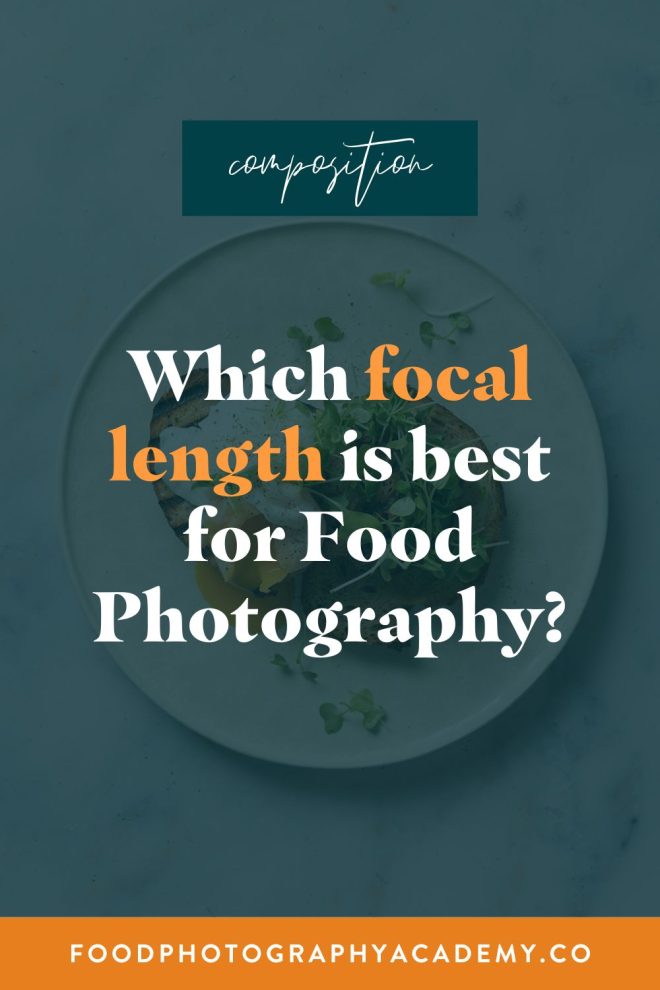
In this post:
How to choose a lens for food photography
What is focal length?
Crop sensor vs full frame cameras
– Calculating focal length on crop sensor cameras
– Common camera brand crop factors
Focal length examples
– Distance Comparison
– Perspective Comparison
How focal length impacts composition
Wrap up
If you prefer to watch, hit play on the video below!
The lenses you use for your food photography will completely change the feel of your photos. Certain focal lengths are better suited to creating some compositions than others.
You don’t need to spend thousands of dollars on a camera or lens to produce great food photography, you just need to know which lens is going to get you the results you’re after. You can find the right lens for you in whatever budget you have.
Stop guessing and start implementing with my foolproof composition system. Elevate your food photography from good to great with composition techniques.
Free Resource
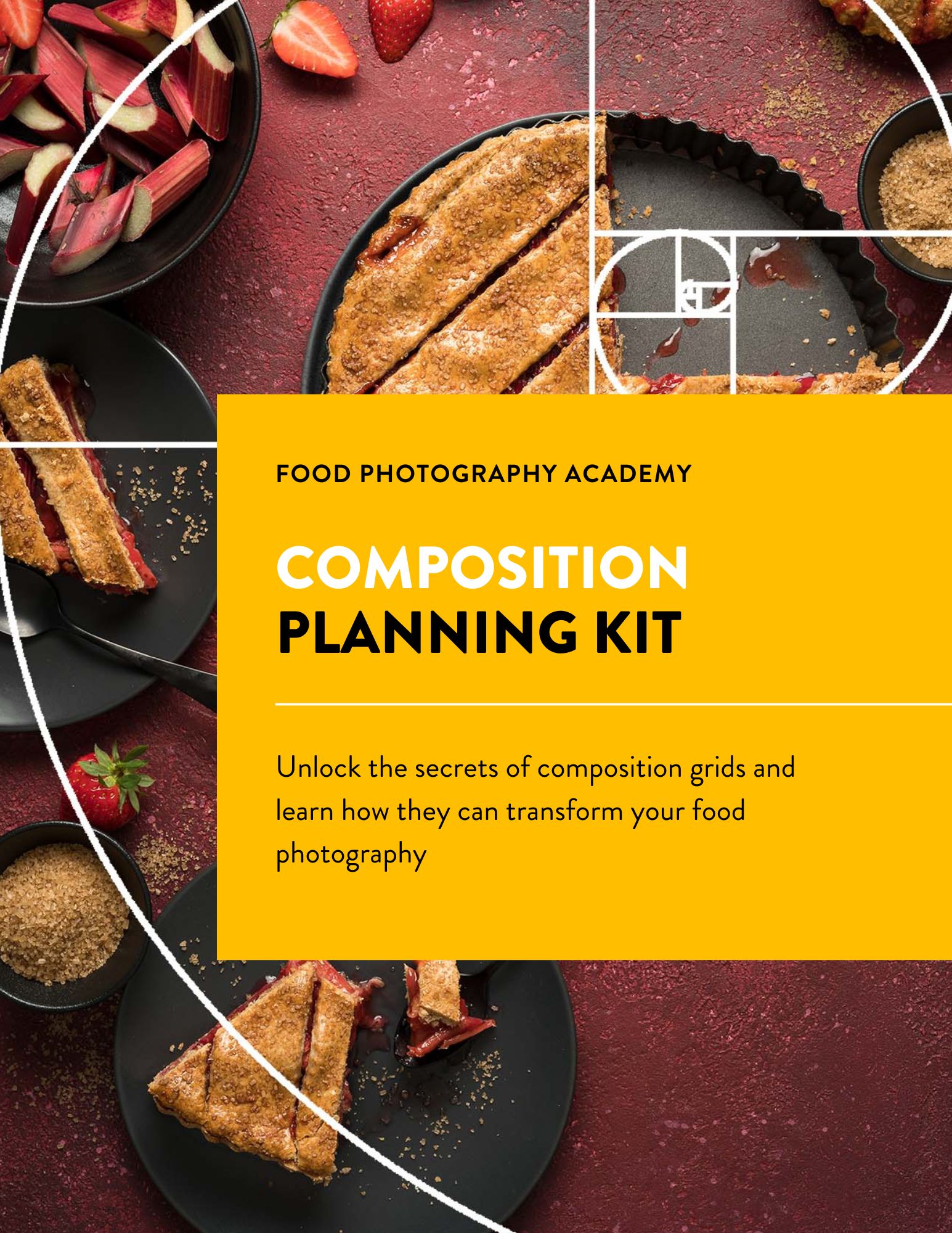
How to choose a lens for food photography
By the end of this series, you’ll understand how different lenses behave on different cameras, what impact this will have on your food photography, and ultimately, how to chose the right lens for you.
We’re going to spend this post understanding what effect the focal length of a lens has on your food photography.
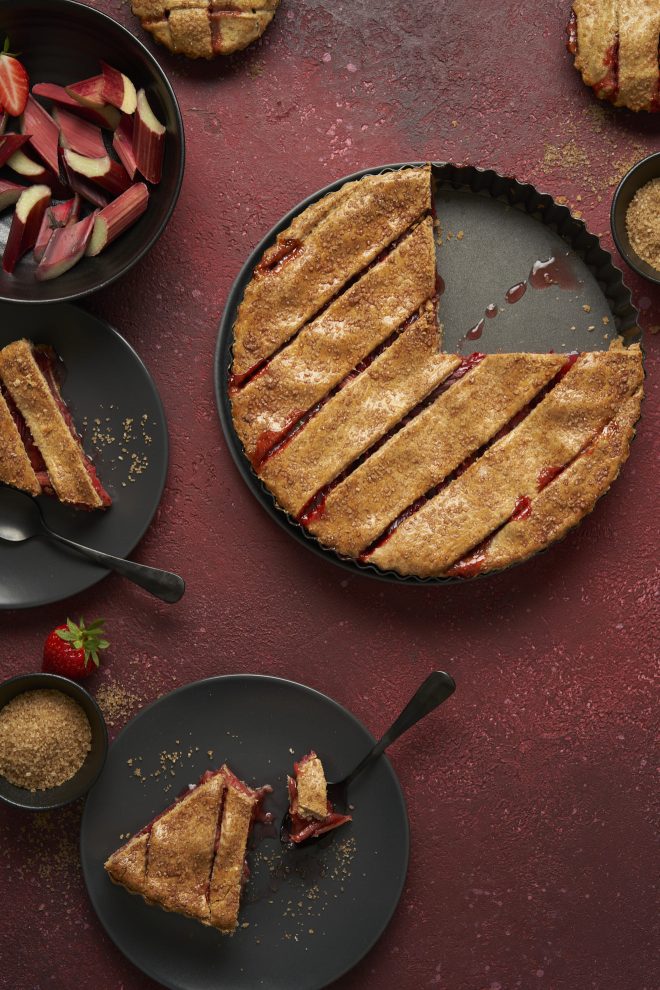

Before we take a look at some focal length examples of food photos, let’s cover some basics.
What is the focal length of a lens?
The focal length is measured in mm, and is the distance between the camera’s sensor and the “point of convergence” (the point at which the light rays cross in your lens to form a sharp image on the sensor).
The lower that mm number is, the wider the “angle of view” the lens has (we’ll look at an example of this later), and the more wide angle the image will appear.
Therefore, a 35mm lens is more “wide angle” than a 50mm lens.
In this post, we’ll look at which lenses are best for different types of food photography.
Crop sensor vs full frame cameras
In order to understand what impact the focal length of a lens has on the photo, we need to understand the difference between a full frame and crop sensor camera.
The sensor in a digital camera is what captures the information that will become your photo. It replaces the function of the film in an analogue camera, so you can think of it as the film of your DSLR or mirrorless camera.
A standard sensor size is equivalent to 35mm film, and we call this a full frame camera. Any smaller sensors are referred to as crop sensor, and anything bigger is either a medium format or a large format sensor.
So what effect does the sensor size have on a lens? Well, it’s actually pretty simple to understand. Here’s an example :
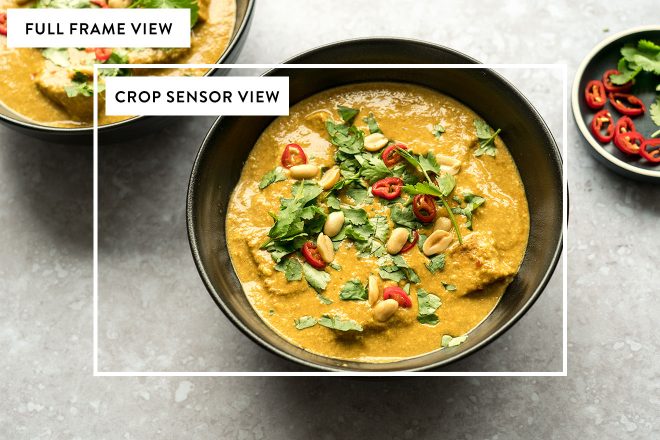
If you were standing in one position with this soup in front of you, the full picture is the photo you would get with a full frame camera. What’s inside the white box is the photo you would get with the same lens on a crop sensor camera.
Calculating focal length for a crop sensor camera
The amount of cropping applied depends on your camera. Each crop sensor camera has a “crop factor”.
Common brand Crop Factors
- Nikon DX generally has a crop factor of 1.5x.
- Sony E (non-FE) has a crop factor of 1.5x
- Canon EF-S/EF-M has a crop factor of 1.6x
- Fujifilm X has a crop factor of 1.5x
- Pentax DA has a crop factor of 1.5x
- Samsung NX has a crop factor of 1.5x
- Sigma Foveon has a crop factor of 1.7x
- Micro Four Thirds has a crop factor of 2.0x
What this means for lenses, is that when you put a lens on a crop sensor camera, you have to multiply the focal length by the crop factor to get your equivalent focal length.
Here’s an example to figure out the equivalent focal length of a 50mm lens being used on a crop frame camera with a crop factor of 1.6x:
50 x 1.6 = 80
Therefore the equivalent focal length = 80mm
Why not pin this handy guide to come back to later?
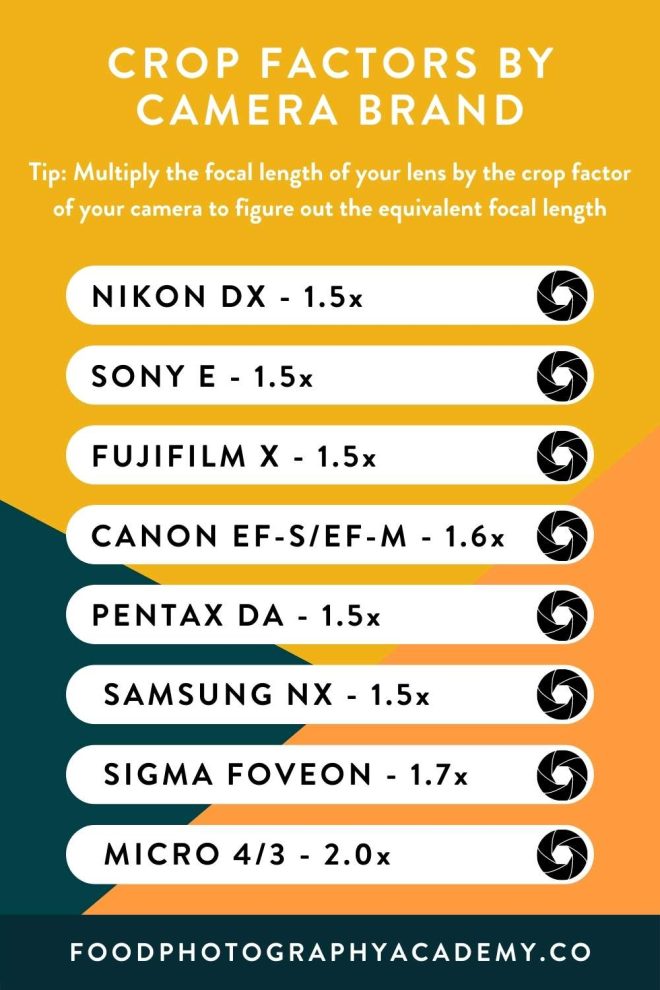
This means that a 50mm lens used on a crop sensor camera with a crop factor of 1.6x will behave like an 80mm lens.
When choosing which food photography lenses to buy, it’s important to only consider the equivalent focal length when you have a crop sensor camera.
Focal Length Examples for Food Photography
To look at this in practice, let’s take a few focal length examples on food photos, so you can see exactly what impact a focal length has on a food photo.
Focal length and distance
In our first example, let’s look at the effect that focal length of the lens has when the camera is in exactly the same position on a tripod. The only thing that we’re going to change is the lens.
Here’s what the camera is seeing through each of the different focal lengths:
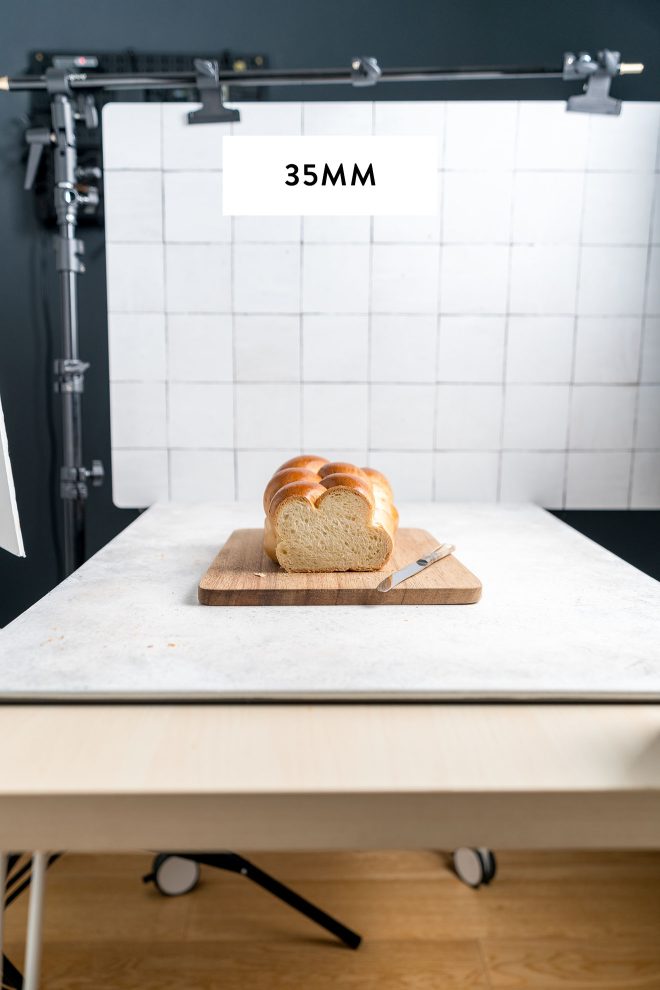

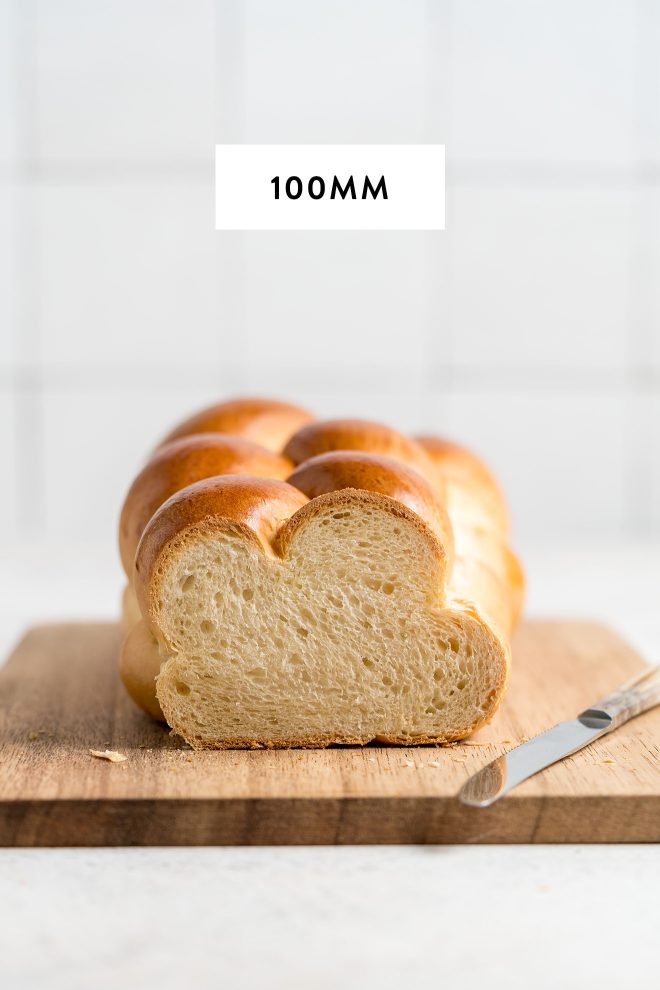
Quite a dramatic difference, huh?
You can clearly see the effect that a longer focal length has. The 35mm lens shows a lot more of the surroundings (because of the wider angle of view), and the 100mm lens is much more “zoomed in” on the bread.
In theory, you could crop the 35mm photo, to show exactly the same amount of the frame as the 50mm or the 100mm, and you’d end up with the same composition. But if you did this to an extreme, you could lose too much resolution for your final image, which is why it’s better to shoot with the correct lens in the first place.
Stop guessing and start implementing with my foolproof composition system. Elevate your food photography from good to great with composition techniques.
Free Resource

Perhaps by now you’re thinking “why can’t I just buy one 35mm lens, and move it closer to the bread to get the composition I want?” Here’s why…
Focal length and perspective
In our next example, rather than keep the tripod in the same position, we’re going to move the camera so we can keep the bread at the same size and in the same place in the frame.
To keep the bread looking the same size, this means that the 28mm lens will be very close up to the bread, and the 100mm lens will be much further away.
Let’s take a look at how different the photos look:

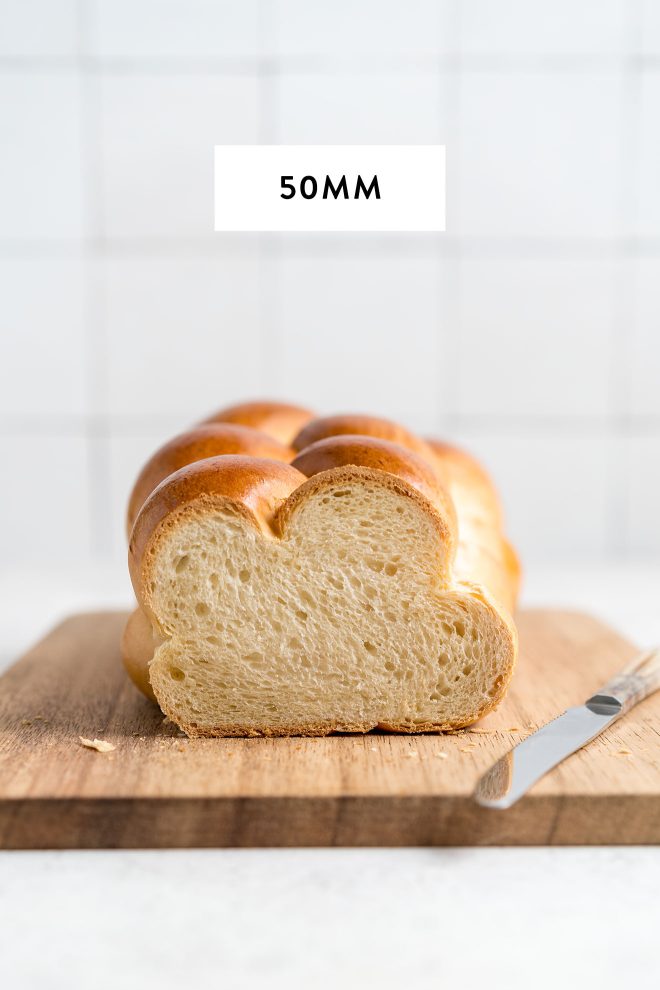
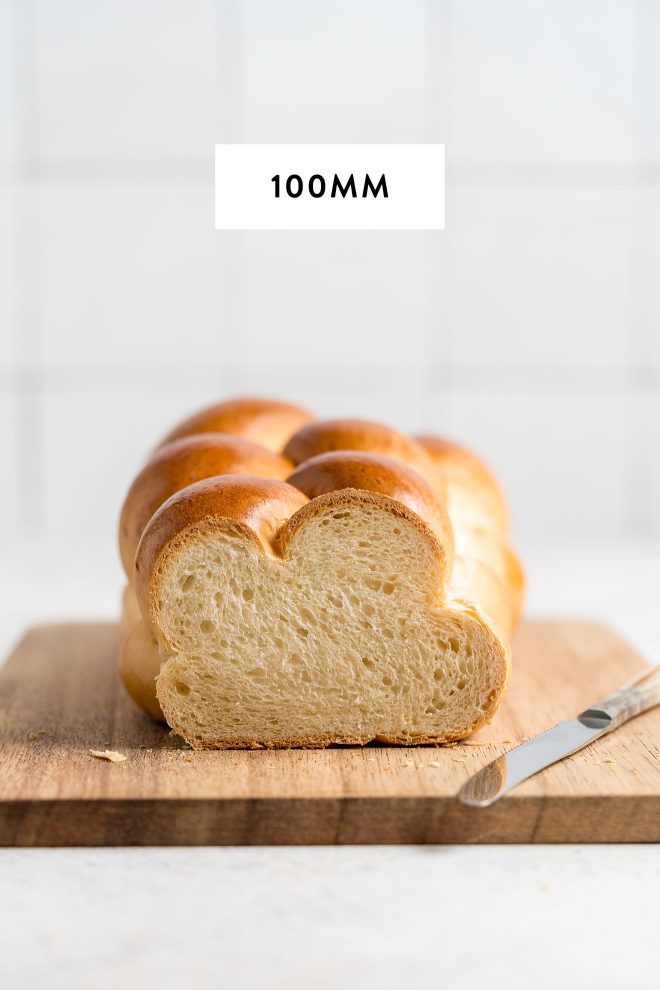
What you’re seeing here is how the perspective changes between the focal lengths, because of the wider field of view that you get with the shorter focal length lenses. You can see this clearly in the board that the bread’s sitting on.
In the 35mm focal length example, the board looks longer at the front, and the knife looks like it’s at a straighter angle. In reality, nothing has been changed or moved at all other than the camera.
A wide angle lens has a stretching effect on the edges of the photo (also known as pincushion distortion), which makes the lines of perspective look more dramatic than they actually are. This can result in something we call the “fishbowl” effect, which we want to avoid in straight on food photography shots.
The last most obvious change is how much of the background is visible. The 100mm gives a much more “cropped” effect. Long focal length lenses are knows as “tighter” lenses, for this reason. This is also why the knife looks like it’s moving around the frame (when it’s not).
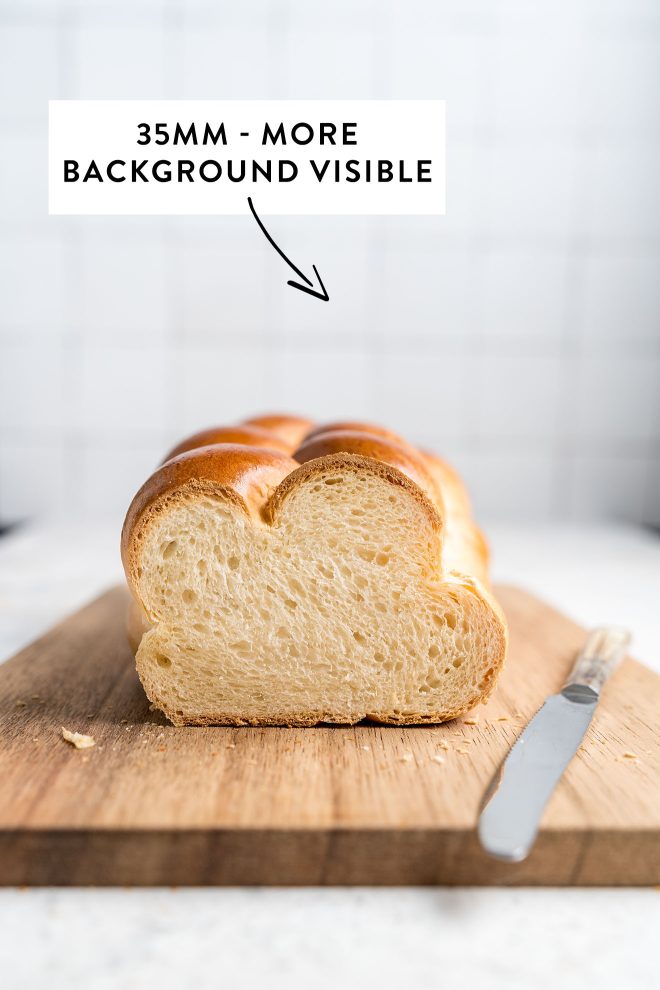
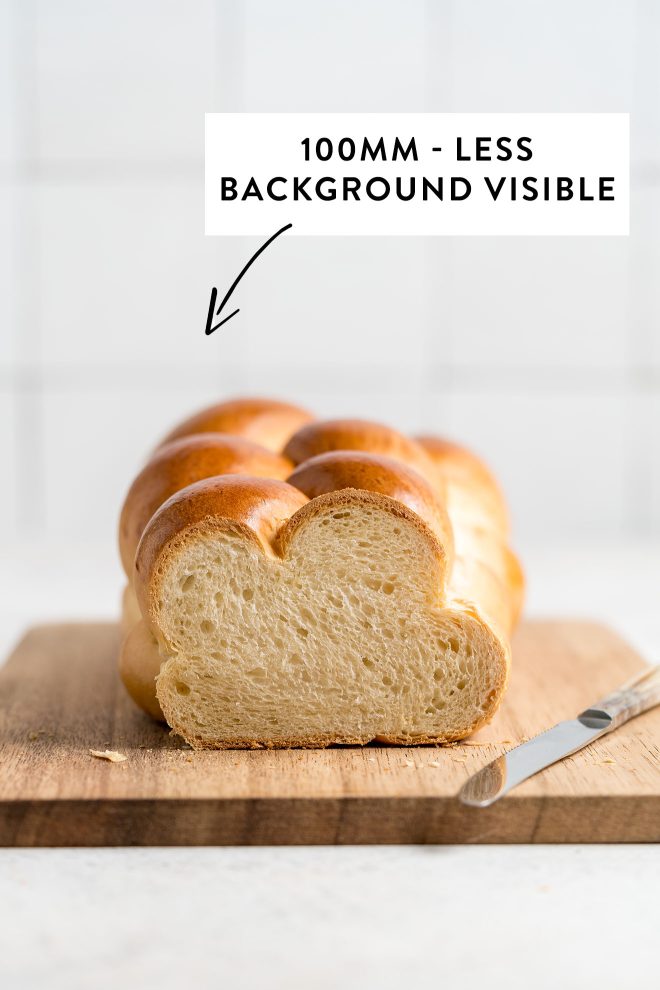
Remember, none of these focal lengths are “better” than the others… they are just different. Each focal length has its place for different kinds of food photography composition. Understanding your style will help you make a much more informed decision about the kind of lenses you need.
Focal Length and Food Photography Composition
So with a lot of technical stuff out of the way, ultimately what this helps you do is choose the best lens for your food shot. The focal length is going to have the biggest impact on the look of your image and your composition.
If you want to create a tight, straight on portrait shot, a 35mm lens will not help you do that. Likewise, if you want to take a wide overhead food photography shot of a large table, a 100mm macro lens isn’t going to be the right choice.
Stop guessing and start implementing with my foolproof composition system. Elevate your food photography from good to great with composition techniques.
Free Resource

Choosing the best lens for food photography
Which brings us nicely onto the next part of this series – How to choose the Best Lens for Food Photography. In this post we’ll look at the ideal focal lengths for crop sensor and full frame cameras, as well as what kind of images they create.
I’m curious…
What lenses are you using for your food photography right now?
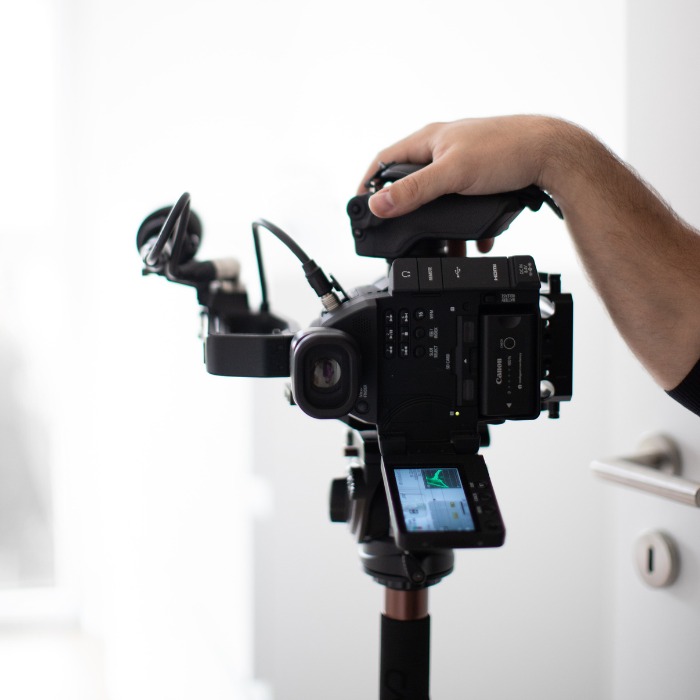
Hi ma’am i am using a Sony alpha 6100 camera which is a mirrorless camera and i got a 15-55mm telephoto lens , but i feel is really a normal lens, with fast AF feature, i’ve read this post and one other of your posts on macro lens, but still i am skeptical on investing in a macro lens, i am going to be using it in dentistry, i am really confused in what lens should i buy, a sony 50mm vs 90 mm macro, please guide me which one to buy .
So glad you found it helpful Marisol!
Hi Lauren, I am new to photography and I have a Canon Rebel Sl1, Cropped Camera… currently I have the 18-55mm lens that originally came with it.
I would like to know what list of lenses you suggest me getting for food Photography?
Thank you,
Aaron
I was wondering what kind / mm size of clip on lenses would be good for food photos with a smartphone
I haven’t personally tried any, but I don’t think they have quite the same effect as you’d hope for. The macro clip ons only really have an effect with SUPER close up images, and fish eye lenses are probably too wide for food photography.
Hi Lauren,
what a great in-depth post! I’m always for geeky stuff 🙂
What are your thoughts on 24-70 mm f/2.8 lens? I know many food photographers swear by it. Since I want to do videos in the future, I was thinking that a zoom lens such as that one isn’t a bad choice?
I still shoot with my Nikon D3400 and a 50 mm f/1.8 lens, but I’m saving money for a full-frame camera. And now I don’t know if I should invest in 24-70 (Tamron or Sigma) or a macro.
Best wishes,
Ana
Hi Ana,
So glad you loved the post! I think the 24-70mm is a great all round investment, especially if you’re wanting to get into video. Your 50mm f/1.4 will transfer really well to a full frame. Honestly I would go for a macro (somewhere in the 90-105mm range) rather than the 24-70 as you already have a 50mm
Great post, Lauren! I wish I had read this 5 years ago! Oh man, so much money was wasted trying to achieve a certain look bc I had NO clue about all this! Wonderful content here! Thx for sharing.
xo
Ash
Well I’m SO glad you read it now! Happy to have helped, Ash
The best! I finally had the AHA moment when I saw the images next to each other. It finally all makes sense. This is so precious. Thank you for putting this together Lauren.
This makes me so happy to read!
Love the way you explain it.
THANK YOU.
Hennie
Thanks so much for the comment Hennie!
hi dear,
I have Nikon DX VR AF-S NIKKOR 18-55mm
1:3,5-5,6 Gıı (I don’t know what all of these stand for)
I couldn’t find where to check my focal length type for it.
what type of lens suits more to my camera?
and is it too bad to shoot with this kit lens?
Hi There! It’s definitely not bad to shoot with your kit lens. Your lens has a focal length of 18-55mm, depending on whether your camera is a crop frame or full frame will affect how it performs. In terms of the best lens, it really depends what kind of food photography you want to create!
Hi Lauren,
Very good post on different types of lens. I currently have canon rebel t5i . I am planning to upgrade to a mid-range camera. Should i go for Canon 80D or Nikon d7200? I need your suggestion and why would you chose that? Thanks!